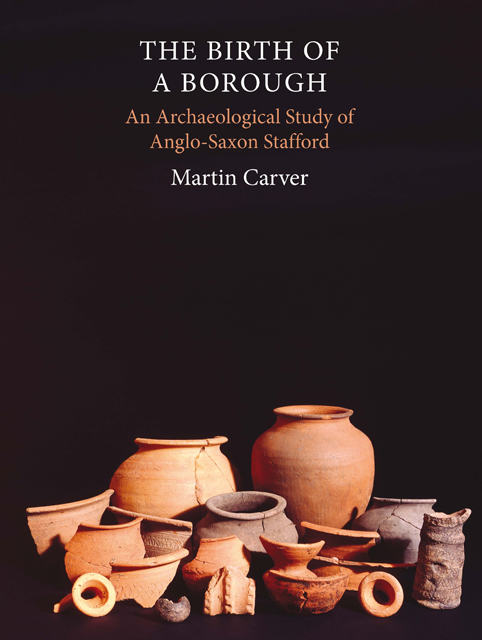Book contents
- Frontmatter
- Contents
- List of Illustrations
- Preface
- Acknowledgements
- Abbreviations
- 1 Questions
- 2 Digging up Stafford: Evaluation and Design
- 3 Seven Windows on Early Stafford: The Principal Investigations
- 4 Æthelflæd’s Town
- 5 Aftermath: Norman and Medieval Stafford
- 6 Anglo-Saxon Stafford in Context
- Digest A1 Archaeological Interventions at Stafford to 1988
- Digest A2 Dendrochronological and Radiocarbon Dates
- Digest A3 Pottery Seriation
- Digest A4 Key to Pottery Illustrations
- Digest A5 Excavated Structures
- Digest A6 Contents of the Stafford Online Archive: http://ads.ahds.ac.uk/catalogue/archive/stafford_eh_2009
- Bibliography
- Index
- Frontmatter
- Contents
- List of Illustrations
- Preface
- Acknowledgements
- Abbreviations
- 1 Questions
- 2 Digging up Stafford: Evaluation and Design
- 3 Seven Windows on Early Stafford: The Principal Investigations
- 4 Æthelflæd’s Town
- 5 Aftermath: Norman and Medieval Stafford
- 6 Anglo-Saxon Stafford in Context
- Digest A1 Archaeological Interventions at Stafford to 1988
- Digest A2 Dendrochronological and Radiocarbon Dates
- Digest A3 Pottery Seriation
- Digest A4 Key to Pottery Illustrations
- Digest A5 Excavated Structures
- Digest A6 Contents of the Stafford Online Archive: http://ads.ahds.ac.uk/catalogue/archive/stafford_eh_2009
- Bibliography
- Index
Summary
In July AD 913 Æthelflæd, Lady of the Mercians, founded Stafford as part of a campaign for the recovery of England from the Danes. She was the commander of the left flank in the northward advance, while her brother Edward the Elder led the pincer movement on the right flank. Wessex had already been won, thanks to the persistence and ingenuity of their father, Alfred the Great.
The primary instrument of this war was the burh, a fortification with provision for residence and trade, which was garrisoned by levy or conscription from its local territory. In Wessex, some record of the procurement system has survived as the Burghal Hidage, which names the places and the human resources required to man them (Fig. 1.1). The places chosen were broadly of three types: former Roman forts or fortified towns, like Winchester, Portchester and Chichester; new foundations that resembled Roman forts, like Wareham, Wallingford and Cricklade; and smaller sites of unknown form at promontories or river junctions, like Lydford and Lyng. Together these places are thought to have formed a defensive system, in which some fortified enclosure was, or was intended to be, in reach of all the people.
The choice of the Wessex sites has been argued to have been determined by the fact that they were already royal property, or the site of an ecclesiastical community, or both. The intention, as perceived from documentary records, was also to canalise trade through these places, and to concentrate the income stream from fines and taxes within them to the benefit of king and church. Such a concept may have been in experimental development at Canterbury, before the age of Alfred. Even if the context of their creation was military, they thus appear as something more than forts, the first manifestation of the English borough. It is perhaps reasonable here to draw a distinction between the nature of places as observed in documents and on the ground. Burh and borough are documentary terms carrying a sense of the chartered town of the Middle Ages that might not be appropriate. On the ground we can define a fort by its fortifications, and a town by its artisan activity.
- Type
- Chapter
- Information
- The Birth of a BoroughAn Archaeological Study of Anglo-Saxon Stafford, pp. 1 - 8Publisher: Boydell & BrewerPrint publication year: 2010



